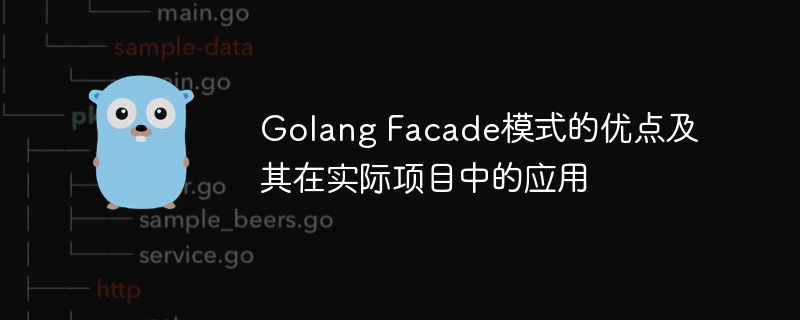

Advantages of Golang Facade pattern and its application in actual projects
Introduction:
In the software development process, in order to simplify the use and invocation of complex systems In the process, we often use design patterns to improve code reusability and maintainability. Among them, the Facade pattern is a very commonly used structural pattern. This article will introduce the advantages of the Facade mode in Golang and give specific code examples based on application scenarios in actual projects.
1. What is Facade mode?
Facade mode, that is, facade mode, is a structural design pattern. It provides a unified interface for accessing a complex set of subsystems in the system. The Facade mode abstracts the complex logic of different subsystems into one interface, so that the client only needs to interact with the subsystem through the Facade interface without caring about the implementation details of the specific subsystem.
The structure of the Facade pattern consists of three parts:
Advantages of Facade mode:
2. Application of Facade mode in Golang
The following is a sample project to illustrate the application of Facade mode in Golang. Suppose we have a system that provides e-shopping functionality, including subsystems such as inventory management, order management, and payment systems.
(1) Inventory Management: InventorySystem
package inventory
type InventorySystem struct {}
// 查询库存
func (is *InventorySystem) CheckInventory(itemId string) int {
// 查询库存逻辑...
return 10
}(2) Order Management: OrderSystem
package order
type OrderSystem struct{}
// 创建订单
func (os *OrderSystem) CreateOrder(itemId string, quantity int) string {
// 创建订单逻辑...
return "12345"
}(3) Payment System: PaymentSystem
package payment
type PaymentSystem struct{}
// 进行支付
func (ps *PaymentSystem) ProcessPayment(orderId string, amount float64) bool {
// 支付逻辑...
return true
}package facade
import (
"github.com/inventory"
"github.com/order"
"github.com/payment"
)
type ShoppingFacade interface {
PlaceOrder(itemId string, quantity int) bool
}
type ShoppingFacadeImpl struct {
inventorySystem *inventory.InventorySystem
orderSystem *order.OrderSystem
paymentSystem *payment.PaymentSystem
}
func NewShoppingFacade(inventorySystem *inventory.InventorySystem, orderSystem *order.OrderSystem, paymentSystem *payment.PaymentSystem) ShoppingFacade {
return &ShoppingFacadeImpl{
inventorySystem: inventorySystem,
orderSystem: orderSystem,
paymentSystem: paymentSystem,
}
}
// 统一接口
func (s *ShoppingFacadeImpl) PlaceOrder(itemId string, quantity int) bool {
// 查询库存
inventory := s.inventorySystem.CheckInventory(itemId)
if inventory >= quantity {
// 创建订单
orderId := s.orderSystem.CreateOrder(itemId, quantity)
// 进行支付
return s.paymentSystem.ProcessPayment(orderId, 100.0)
}
return false
}package main
import (
"github.com/facade"
"github.com/inventory"
"github.com/order"
"github.com/payment"
)
func main() {
// 初始化子系统
inventorySystem := &inventory.InventorySystem{}
orderSystem := &order.OrderSystem{}
paymentSystem := &payment.PaymentSystem{}
// 创建Facade接口实例
shoppingFacade := facade.NewShoppingFacade(inventorySystem, orderSystem, paymentSystem)
// 使用Facade接口
result := shoppingFacade.PlaceOrder("item1", 2)
if result {
// 订单创建成功
} else {
// 库存不足或支付失败
}
}Through the above sample code, we have implemented the Facade interface of an electronic shopping system, and the complex logic of subsystems such as inventory management, order management, and payment systems is encapsulated through the Facade.
Summary:
Facade mode in Golang can help us simplify the access and calling process of complex systems, provide a unified interface, reduce the coupling between systems, and improve the maintainability of the code functionality and reusability. The above are the advantages of the Facade mode in Golang and its application in actual projects. I hope it will be helpful to everyone.
The above is the detailed content of Advantages of Golang Facade pattern and its application in actual projects. For more information, please follow other related articles on the PHP Chinese website!




